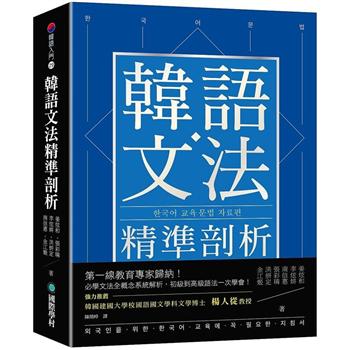Nanoscience is a part of science that studies small stuff, it’s not biology, physics or chemistry, it’s all sciences that work with the very small. Nanotechnology is the art and science of making useful stuff that does stuff on the nanometer length scale and includes advances in all industries, including the electronic, chemical, medical, and pharmaceutical. Nanomedicine is the medical application of nanotechnology and related research which is innovative technology of materials science and biology. Designed as a broad survey of the field, this book is divided into three main sections:
•Nanophysic
•Nanochemistry
•Nanomedicine
Each chapter describes in detail currently valuable methods and contains numerous references to the primary literature, making this the perfect “filed guide” for biologists and physicians who want to explore the fascinating world of nanotechnology.
| FindBook |
有 5 項符合
The Nanoscience in Translational Medicine的圖書 |
 |
The Nanoscience in Translational Medicine 作者:Hossein Hosseinkhani,Keng-Liang Ou 出版社:五南圖書出版股份有限公司 出版日期:2015-06-29 語言:繁體書 |
| 圖書選購 |
| 型式 | 價格 | 供應商 | 所屬目錄 | $ 1520 |
疾病醫療 |
$ 1520 |
科學‧科普 |
$ 1520 |
社會人文 |
$ 1520 |
高等教育 |
$ 1600 |
生命科學總論 |
|---|
| 圖書館借閱 |
| 國家圖書館 | 全國圖書書目資訊網 | 國立公共資訊圖書館 | 電子書服務平台 | MetaCat 跨館整合查詢 |
| 臺北市立圖書館 | 新北市立圖書館 | 基隆市公共圖書館 | 桃園市立圖書館 | 新竹縣公共圖書館 |
| 苗栗縣立圖書館 | 臺中市立圖書館 | 彰化縣公共圖書館 | 南投縣文化局 | 雲林縣公共圖書館 |
| 嘉義縣圖書館 | 臺南市立圖書館 | 高雄市立圖書館 | 屏東縣公共圖書館 | 宜蘭縣公共圖書館 |
| 花蓮縣文化局 | 臺東縣文化處 |
|
|
圖書介紹 - 資料來源:博客來 評分:
圖書名稱:The Nanoscience in Translational Medicine
內容簡介
作者介紹
作者簡介
Hossein Hosseinkhani
Prof. Hossein Hosseinkhani received his B.Sc degree (National Gold Medalist) in Chemical Engineering from Polytechnique University, M.Sc degree (First class, First rank) in Chemical Engineering from Tarbiat Modarres University, and Ph.D degree (Excellent with Honor) in Polymer Chemistry in the field of Biomedical Engineering from Kyoto University in 2002. Dr. Hosseinkahni has broad experience in life sciences and is expert in nanotechnology, biomaterials and stem cells technology for regenerative medicine and biomedical engineering applications. He has been awarded several prestigious fellowships including JSPS Fellowship of Japan at Institute for Frontier Medical Sciences, Kyoto University Hospital (2002–2004), ICYS Research Fellow of Japan at Notational Institute for Materials Science (2004–2008), IRIIMS Research Fellow of Japan at International Research Institute for Integrated Medical Sciences, Tokyo Women’s Medical University (2008–2009), and Visiting Scientist at Center for Biomedical Engineering, Massachusetts Institute of Technology (MIT), USA (2007–2009). Dr. Hosseinkhani has 50 issued Japan and U.S. patents, several U.S. patents pending and has authored over 100 international publications in prestigious international journals and over 200 presentations at international conferences till present time. Currently, he is Director of Bioengineering Program and Professor at the Graduate Institute of Biomedical Engineering, National Taiwan University of Science and Technology (Taiwan Tech).
Keng-Liang Ou
Professor Keng-Liang Ou obtained his Ph.D. degree from Graduate Institute of Mechanical Engineering, National Chiao Tung University, Taiwan. He joined Taipei Medical University to pursue the cutting-edge research of biomaterials and currently holds the position of Dean of College of Oral Medicine. He is also the Director of Research Center for Biomedical Implants and Microsurgery Devices and the Director of Research Center for Biomedical Devices and Prototyping Production. Besides institutional appointment, Prof. Ou serves as the President of Institute of Plasma Engineering in Taiwan, the Director of the Taiwan Society for Metal Heat Treatment, the President of Taiwan Oral Biomedical Engineering Association and the Director of Yongee Anti-cancer Foundation. Professor Ou devotes himself to the novel research in the fields of biomaterials, bioengineering, biosensing, bioimaging, and translational medicine. In addition, he establishes extensive collaborations with industry and has played a leading role in developing medical devices for health professionals worldwide. He is the leader and organizer for the biomedical product design, production, manufacturing, testing, legalization and market planning, with supports from teams of scientists and researchers with expertise in different fields. With the outstanding accomplishments in research and invention, Professor Ou received the Award of the Ten Outstanding Young Persons of Taiwan in the year of 2011 and the TMU Distinguished University Professor Award in 2014.
Hossein Hosseinkhani
Prof. Hossein Hosseinkhani received his B.Sc degree (National Gold Medalist) in Chemical Engineering from Polytechnique University, M.Sc degree (First class, First rank) in Chemical Engineering from Tarbiat Modarres University, and Ph.D degree (Excellent with Honor) in Polymer Chemistry in the field of Biomedical Engineering from Kyoto University in 2002. Dr. Hosseinkahni has broad experience in life sciences and is expert in nanotechnology, biomaterials and stem cells technology for regenerative medicine and biomedical engineering applications. He has been awarded several prestigious fellowships including JSPS Fellowship of Japan at Institute for Frontier Medical Sciences, Kyoto University Hospital (2002–2004), ICYS Research Fellow of Japan at Notational Institute for Materials Science (2004–2008), IRIIMS Research Fellow of Japan at International Research Institute for Integrated Medical Sciences, Tokyo Women’s Medical University (2008–2009), and Visiting Scientist at Center for Biomedical Engineering, Massachusetts Institute of Technology (MIT), USA (2007–2009). Dr. Hosseinkhani has 50 issued Japan and U.S. patents, several U.S. patents pending and has authored over 100 international publications in prestigious international journals and over 200 presentations at international conferences till present time. Currently, he is Director of Bioengineering Program and Professor at the Graduate Institute of Biomedical Engineering, National Taiwan University of Science and Technology (Taiwan Tech).
Keng-Liang Ou
Professor Keng-Liang Ou obtained his Ph.D. degree from Graduate Institute of Mechanical Engineering, National Chiao Tung University, Taiwan. He joined Taipei Medical University to pursue the cutting-edge research of biomaterials and currently holds the position of Dean of College of Oral Medicine. He is also the Director of Research Center for Biomedical Implants and Microsurgery Devices and the Director of Research Center for Biomedical Devices and Prototyping Production. Besides institutional appointment, Prof. Ou serves as the President of Institute of Plasma Engineering in Taiwan, the Director of the Taiwan Society for Metal Heat Treatment, the President of Taiwan Oral Biomedical Engineering Association and the Director of Yongee Anti-cancer Foundation. Professor Ou devotes himself to the novel research in the fields of biomaterials, bioengineering, biosensing, bioimaging, and translational medicine. In addition, he establishes extensive collaborations with industry and has played a leading role in developing medical devices for health professionals worldwide. He is the leader and organizer for the biomedical product design, production, manufacturing, testing, legalization and market planning, with supports from teams of scientists and researchers with expertise in different fields. With the outstanding accomplishments in research and invention, Professor Ou received the Award of the Ten Outstanding Young Persons of Taiwan in the year of 2011 and the TMU Distinguished University Professor Award in 2014.
目錄
Chapter 1 Nanofabrication
1.1 ntroduction
1.2 Size Matters
1.3 Nanofabrication
1.4 Impact of Nanotechnology
1.5 Nanotechnology Applications
1.6 Summary and Challenges
References
Chapter 2 Self-Assembled Nanomaterials
2.1 Introduction
2.2 Classification of Self-Assembled Systems
2.3 In vitro Biological Approaches of Self-Assembled Systems
2.4 Regenerative Medicine Therapy
2.5 Future Prospects
References
Chapter 3 Nanoparticles in Gene Therapy
3.1 Introduction
3.2 Approaches to Gene Therapy
3.3 Physical Methods for Gene Delivery
3.4 Combination of Physical and Non-viral Methods to Enhance DNA Nanoparticle Uptake by the Cells
3.5 Summary
References
Chapter 4 Dry Particles Coating Processes
4.1 Introduction
4.2 Dry Coating Process
4.3 Determination of Particles
4.4 Application of Dry Coating Process
4.5 Current and Future Developments
References
Chapter 5 Polymeric Nanoparticles for Therapy and Imaging
5.1 Introduction
5.2 Polymeric Nanoparticles in MRI
Technology and Disease Therapy
5.3 Surface Coating Polymer in Nanoparticles
5.4 Drug Delivery with Polymeric Nanoparticles
5.5 Stimuli-Sensitive Drug Delivery
5.6 Multifunction of Targeted Drug Delivery
5.7 Gene Transfer via Polymeric Nanoparticles in Drug Delivery
5.8 Magnetic Hyperthermia
5.9 Summary
References
Chapter 6 Modified Release Natural Polymerci Nanoparticles
in Drug Delivery Technology
6.1 Introduction
6.2 Polymers
6.3 Fabrication of Particles by Using Natural
Polymers
6.4 Modified Prticles
6.5 Oral Delivery Systems
6.6 Formulation Approaches for Local Delivery
6.7 Role of Buccal Permeation Enhancer
6.8 Overview of Novel Buccal Drug Delivery Devices
6.9 Conclusion and Future Prospects
References
Chapter 7 Nanopattering Technology
7.1 Introduction
7.2 Three Dimensional (3D) Scaffolding Materials for Biological Application
7.3 Current Approaches of Nanofabrication
by Using Lithography
7.4 Future Approaches
7.6 Milestones, Deliverables, and Economic Potential
References
1.1 ntroduction
1.2 Size Matters
1.3 Nanofabrication
1.4 Impact of Nanotechnology
1.5 Nanotechnology Applications
1.6 Summary and Challenges
References
Chapter 2 Self-Assembled Nanomaterials
2.1 Introduction
2.2 Classification of Self-Assembled Systems
2.3 In vitro Biological Approaches of Self-Assembled Systems
2.4 Regenerative Medicine Therapy
2.5 Future Prospects
References
Chapter 3 Nanoparticles in Gene Therapy
3.1 Introduction
3.2 Approaches to Gene Therapy
3.3 Physical Methods for Gene Delivery
3.4 Combination of Physical and Non-viral Methods to Enhance DNA Nanoparticle Uptake by the Cells
3.5 Summary
References
Chapter 4 Dry Particles Coating Processes
4.1 Introduction
4.2 Dry Coating Process
4.3 Determination of Particles
4.4 Application of Dry Coating Process
4.5 Current and Future Developments
References
Chapter 5 Polymeric Nanoparticles for Therapy and Imaging
5.1 Introduction
5.2 Polymeric Nanoparticles in MRI
Technology and Disease Therapy
5.3 Surface Coating Polymer in Nanoparticles
5.4 Drug Delivery with Polymeric Nanoparticles
5.5 Stimuli-Sensitive Drug Delivery
5.6 Multifunction of Targeted Drug Delivery
5.7 Gene Transfer via Polymeric Nanoparticles in Drug Delivery
5.8 Magnetic Hyperthermia
5.9 Summary
References
Chapter 6 Modified Release Natural Polymerci Nanoparticles
in Drug Delivery Technology
6.1 Introduction
6.2 Polymers
6.3 Fabrication of Particles by Using Natural
Polymers
6.4 Modified Prticles
6.5 Oral Delivery Systems
6.6 Formulation Approaches for Local Delivery
6.7 Role of Buccal Permeation Enhancer
6.8 Overview of Novel Buccal Drug Delivery Devices
6.9 Conclusion and Future Prospects
References
Chapter 7 Nanopattering Technology
7.1 Introduction
7.2 Three Dimensional (3D) Scaffolding Materials for Biological Application
7.3 Current Approaches of Nanofabrication
by Using Lithography
7.4 Future Approaches
7.6 Milestones, Deliverables, and Economic Potential
References
|










